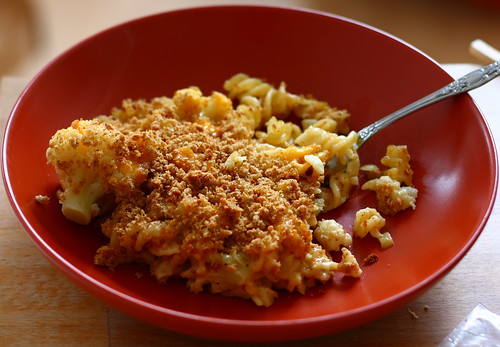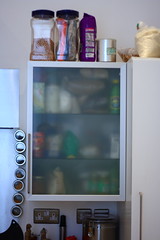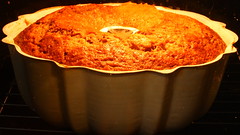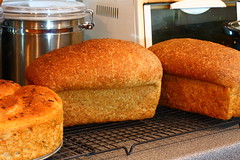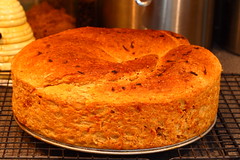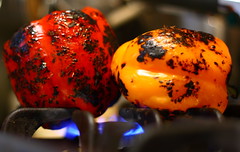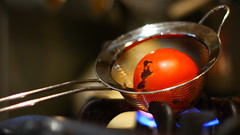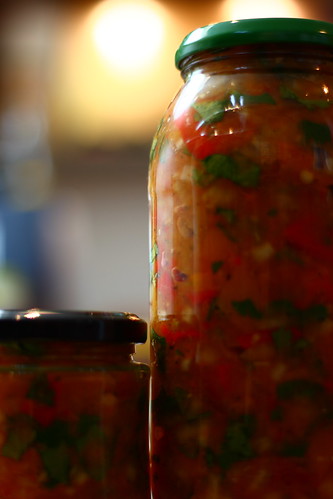
Occasionally, the taste buds get bored.
Oh, sure, you can have your lovely, light, chewy loaves of bread, and your fragrant basmati rice steaming away. You can have your light pancakes and rich cream sauces. But sometimes… you just long for the freshness of summer — roasted vegetables, fajitas, crisp, fresh watermelon, juicy nectarines.
But, alas, at the moment you’re in Scotland. Where it snowed again this week. Twice.
You’ve already started pickling things. It might be time to take it one step further… into pico de gallo-land.
Salsa picada, salsa mexicana — whatever you’ve grown up calling it, pico de gallo, which literally means “beak of rooster” is a sharp, chunky, colorful sauce that goes well as a sort of spicy relish with meat or on top of beans with a bit of sour cream, wrapped into a soft taco. The base ingredients match the colors of the Mexican flag — red, white and green. Tomatoes, onions, and chilies.
That’s just a place to start, of course. When your tastebuds are bored, you can jump off and find yourself in a number of places. Desire is an imprecise map. This is the path we took and we ended up happy.
We started our pico with fire-roasted bell-peppers, mainly because for some people, bell peppers are inedible without the skin removed. The charring gives peppers a smoky sweetness and removes the bitterness that sometimes lingers when they’re sauteéd, and because frankly — pyromania is fun. (Wear sleeves that are tight to your wrists, please. And don’t set the house on fire. You can try this using an electric burner, but don’t touch the pepper to the metal, or it’ll stick. And for goodness sakes, don’t hold it in your hand..!) This time of year, we don’t have too many tomatoes around, so we stretch what we have by using red and yellow bells.
And so, to roast them: with a pair of long metal tongs, take a washed bell pepper, turn on the smallest burner on your gas stove and set the pepper atop it, directly atop the burner. At intervals — mainly when the skin you can see is blistered and blackened — turn the pepper with the tongs. Finito. That’s it. Depending on the size of the pepper and the thickness of the pepper-flesh, this will take between five and ten minutes, five minute per side. You might want to run the fan, since the skin kind of makes the house smell like an illegal recreational drug, I’m told. It just smells kind of rank in the beginning of the process, but then the sweetness of the pepper comes through, and it smells like… fajitas. *sigh*
Don’t be afraid to really roast your peppers — don’t fear the charring, people. Black, black, black is what you’re looking for. Check out this picture from Vegan Yum Yum to see what I mean. Or try it under the broiler. (I should have taken pictures of this stage of the game, but I didn’t remember that people might not know how to do this without a barbecue grill.)
While your peppers are charring, take one large, mild, yellow onion — a mild and sweet Walla Walla would do nicely — and chop it finely. We smashed three cloves of garlic and minced them as well. Place your onion and garlic into a reaction proof bowl. Deseed and chop six large tomatoes (or, in our case, four medium tomatoes and a bunch of wee cherry tomatoes that were left over from a salad) and add to the melee. Carefully mince and add one or two chillies of your choice. We used three Thai bird chillies — which are extremely long and thin and red and pack a punch. You might want to use serranos or jalapeños — after all, that will give you the green for the flag. You could roast these peppers as well, but we chose not to — Thai bird chillies are searingly hot, and roasting a chili pepper simply ups the capsicum level. Since we also added several big grinds of black pepper to this mix and have three cloves of garlic in there too, we didn’t need that kind of firepower. This time.

You can do a ton of things with fire roasted peppers — from a tasty tapanade to just tossing them with capers and green olives and a drizzle of lemon juice and olive oil in capellini — there are myriad options. Right now, though, it’s time to skin them.
If your peppers look irrevocably burnt and inedible, it’s a good sign they’ve charred enough. Drop them into a plastic bag, and leave them to steam gently for about five minutes. You can also use a paper bag. The peppers will have deflated and gone soft and quite moist. You’ll need to rub them with a dry towel to begin to remove the skin — they’ll be cooled some, but not all the way, so be careful. Use a dampened paper towel to wash away the black bits, but leaving some doesn’t hurt. Cut out the core — the stem and the seeds — and mince.
We added two tablespoons of lemon juice and a tablespoon of vinegar, a handful of snipped chives, and freshly ground pepper to taste. If we’d had any on hand, we would also have added about four tablespoons of freshly minced cilantro — or what’s known as coriander here, but the basic recipe is just tomatoes, onions and chilies, so you use what you’ve got. We left this mixture jarred on the counter overnight, so that the flavors had time to mingle in room temperature, and then refrigerated the next day.
It is so tasty, and can be used in tacos and burritos or on nachos — or in the same way that you would use a chutney. Conversely, you could just eat it loaded onto chips with guacamole…. While eating a whole bunch will give you onion breath for awhile, it’s so worth it.


